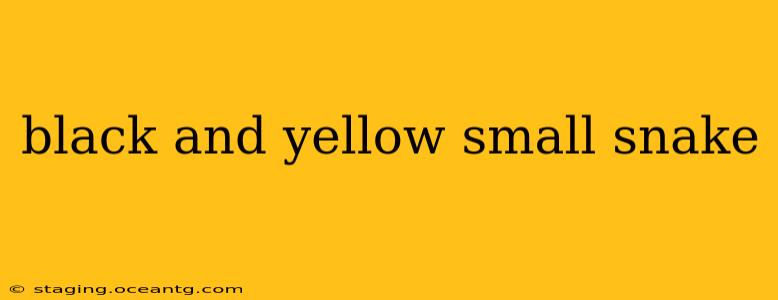Encountering a small black and yellow snake can be alarming, but identifying the species is crucial for determining the appropriate course of action. Several snake species exhibit this color combination, and knowing which one you've found helps determine if it poses a threat and how best to handle the situation. This guide will help you identify some common black and yellow snakes and address frequently asked questions.
What kind of small black and yellow snake is this?
This is a broad question, as numerous snakes feature black and yellow patterns. The location is key to narrowing down possibilities. For example, a small black and yellow snake in the southeastern United States might be a yellow-bellied racer, while a similar snake in the southwestern US could be a Sonoran coral snake (though coral snakes are typically more brightly colored). To identify the snake accurately, you'll need to consider:
- Location: Where did you see the snake? State, region, and even specific habitat (e.g., near water, in a grassy field, etc.) are vital.
- Size: How long was the snake approximately?
- Pattern: Describe the pattern precisely. Are the yellow and black bands distinct? Are there other colors present? Are the bands continuous or broken?
- Shape and Head: Is the head distinct from the body? What shape is the head? Rounder heads often indicate non-venomous snakes, while triangular heads are more common in venomous species.
Providing these details to a herpetologist or using a reliable online field guide (with caution—always double-check identifications with multiple sources) can significantly improve identification accuracy.
Is a small black and yellow snake poisonous?
Some black and yellow snakes are venomous, while many are harmless. The most critical distinction lies in identifying the specific species. For instance, Sonoran coral snakes are venomous, but many other small black and yellow snakes, such as yellow-bellied racers, are not. Never attempt to handle a snake you cannot positively identify. If you are unsure, assume it is venomous and keep a safe distance.
What are some common small black and yellow snakes?
Several snake species exhibit black and yellow markings. Some examples include:
- Yellow-bellied Racer ( Coluber constrictor flaviventris): Common in the eastern United States, this fast-moving snake is harmless to humans. It is typically slender with a black and yellow pattern, though the yellow can vary in intensity.
- Sonoran Coral Snake (Micrurus tener): Found in the southwestern United States and Mexico, this snake is venomous. Its coloration is similar to other harmless snakes (mimicry), making careful identification crucial.
- Eastern Yellow-bellied Racer (Coluber constrictor): A larger relative of the Yellow-bellied Racer. Harmless.
These are just a few examples, and many other snakes may have similar coloration depending on their geographic location and individual variations.
How do I identify a venomous small black and yellow snake?
Identifying a venomous snake requires careful observation and ideally, expert consultation. Look for these features:
- Triangular Head: Venomous snakes often have a broader, triangular head.
- Thick Body: Venomous snakes generally have proportionally thicker bodies compared to their length.
- Specific Pattern: Coral snakes have distinct red, black, and yellow bands, often with the red and yellow bands adjacent to each other (a key difference from the harmless milk snake mimics).
- Pupil Shape: While not always definitive, some venomous snakes have elliptical pupils.
Again, never handle a snake you are unsure of. If you are concerned you have encountered a venomous snake, seek expert assistance.
What should I do if I see a small black and yellow snake?
Your response should depend on your location and the apparent nature of the snake.
- Observe from a distance: Do not approach the snake. Observe its behavior and try to take note of its features for identification purposes.
- Do not attempt to handle it: Even if you believe it is harmless, handling wild snakes is risky.
- Keep pets and children away: Protect your pets and children from any potential danger.
- Consult resources: Utilize online field guides (used cautiously) or contact a local wildlife expert or herpetological society for identification assistance.
- Seek professional assistance if needed: If you believe you have encountered a venomous snake and feel unsafe, contact animal control or a wildlife removal service.
By carefully observing the snake's characteristics and utilizing reliable resources, you can better understand and appreciate this often-misunderstood creature. Remember, safety should always be your top priority.
